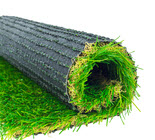Buyer's Guide
Residential Artificial Turf Introduction

Artificial turf is an attractive and nearly maintenance free alternative to a natural grass lawn. It's ideal for people who want a green, manicured lawn year round, but don't want to spend a much time on yard work.
Synthetic grass was first introduced in the 1960s for professional sports teams, and is now widely used in all levels of sports for indoor and outdoor fields. But the ease of maintenance makes it a great option for residential landscaping, too. The cost has also come down as technologies have improved, making artificial turf a realistic option for homeowners today.
Modern artificial turf is nearly indistinguishable from natural grass in appearance and texture. It can be installed with a sand or rubber infill that acts as an extra cushion, making it an ideal surface for children to play. It can be used to cover an entire lawn or just in specific areas - around a pool or playground, for example.
Advantages of artificial turf
One of the greatest benefits of artificial turf is that it requires very little maintenance when compared to natural grass. Your lawn always looks perfectly manicured with no need to mow, water, weed, or reseed. This saves both time and money.
Homeowners with artificial turf never have to replace a lawnmower, pay a landscaper, or trek to the hardware store for grass seed or weed killers. With no need for sprinklers or irrigation, water bills drop substantially.
The environmental benefits have also lured some homeowners - artificial turf allows them to conserve a significant amount of water each year and eliminates the need for pesticides. Other benefits of synthetic turf include:
- Holds up to wear and tear far better than natural grass
- Safe for children and pets
- Easy to clean
- Can increase the resale value of your home
- Doesn't attract bugs and other pests like natural grass
- No grass stains
- No bare or brown spots
However, artificial turf does have its disadvantages. It tends to get hotter than natural grass and materials on the surface don't break down as easily. And despite the advances in technology, less expensive types of artificial turf still may not have as much give as grass.
Materials, Maintenance, Life Expectancy & Pricing
Materials, maintenance and life expectancy
Artificial turf is constructed in much the same way as the carpet in your home. There are two major components - fibers and backing. The fibers, or "blades," are made up of tough nylon or a material called polypropylene, while the backing is typically plastic or polyester.
Generally, artificial turf lasts beyond 20 years with proper upkeep, and potentially up to 30 years. Many dealers offer warranties of 8 years or more. Most varieties of turf have a coating to protect against UV rays and prevent fading.
Although maintenance is minimal, it is important to "freshen" the turf and remove debris from time to time using a leaf blower, rake or brush. To clean up pet waste, simply rinse off the turf and allow the water to drain.
Cost of artificial turf
There's a significant upfront investment required with artificial turf. However, over the life of an artificial lawn, the cost can be recouped through maintenance savings.
The turf itself, without factoring in the cost of installation, typically runs between $2 and $6 per square foot. If you're going to do the job yourself, factor in another $2 or $3 per square foot for other materials. The turf is typically sold in rolls that are 15 feet wide and 60 to 100 square feet long - totaling up to 1,500 square feet and weighing hundreds of pounds.
Professional installation runs about $8 to $20 per square foot, but the price is heavily influenced by variable factors such as how much preparation the site needs and local fuel and labor prices. A dealer or contractor will likely have to visit your site before giving you an exact price for the project.
At a median price of $14 per square foot for professional installation, a 2,000 square foot yard would cost $28,000. That works out to $1,400 a year over 20 years. At that same price per square foot, a 600-square-foot playground would cost $8,400.
Installation & Tips
Installation
Proper installation is crucial for ensuring a long lifespan for your artificial lawn. Before the turf can be installed, your lawn may need to be leveled and configured for proper drainage. A contractor that meticulously prepares a site may charge more - but the extra cost is well worth it.
Once installed, turf can be "filled" with rubber or sand that helps creates a cushion below your feet. This extra step is probably worth the money if your lawn gets a lot of use, particularly from kids playing. But it's not worth the expense if your grass is just for show.
Tips for buyers
- Some homeowners associations place restrictions on artificial turf, so it's a good idea to check with your association or your local planning department before making a purchase.
- Be wary of quality - there's a big difference between outdoor carpet and artificial turf. Just because the turf is green doesn't mean it will hold up to years of high traffic.
- Make sure the artificial turf you choose comes with a warranty of at least 8 years. Although it should actually last much longer, 8 years is a reasonable standard in the industry for a warranty.
- Set a budget ahead of time and stick to it. Don't forget to factor in maintenance costs, no matter how minimal. If you don't want to be bothered with raking or rinsing the turf occasionally, keep in mind that you will have to pay someone to do it.
